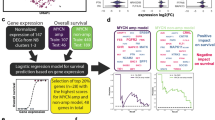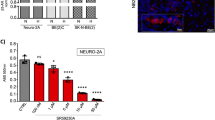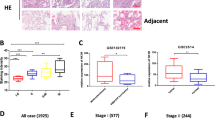Abstract
Neuroblastoma (NB) is a pediatric tumor of neural crest origin with heterogeneous phenotypes. Although low-stage tumors carry a favorable prognosis, >50% of high-risk NB relapses after treatment with a fatal outcome. Thus developing therapies targeting refractory NB remains an unsolved clinical problem. Brain-derived neurotrophic factor (BDNF) and its TrkB receptor are known to protect NB cells from chemotherapy-induced cell death, while neuropeptide Y (NPY), acting via its Y2 receptor (Y2R), is an autocrine proliferative and angiogenic factor crucial for maintaining NB tumor growth. Here we show that in NB cells, BDNF stimulates the synthesis of NPY and induces expression of another one of its receptors, Y5R. In human NB tissues, the expression of NPY and Y5R positively correlated with the expression of BDNF and TrkB. Functionally, BDNF triggered Y5R internalization in NB cells, whereas Y5R antagonist inhibited BDNF-induced p44/42 mitogen-activated protein kinase activation and its pro-survival activity. These observations suggested TrkB-Y5R transactivation that resulted in cross-talk between their signaling pathways. Additionally, NPY and Y5R were upregulated in a BDNF-independent manner in NB cells under pro-apoptotic conditions, such as serum deprivation and chemotherapy, as well as in cell lines and tissues derived from posttreatment NB tumors. Blocking Y5R in chemoresistant NB cells rich in this receptor sensitized them to chemotherapy-induced apoptosis and inhibited their growth in vivo by augmenting cell death. In summary, the NPY/Y5R axis is an inducible survival pathway activated in NB by BDNF or cellular stress. Upon such activation, Y5R augments the pro-survival effect of BDNF via its interactions with TrkB receptor and exerts an additional BDNF-independent anti-apoptotic effect, both of which contribute to NB chemoresistance. Therefore, the NPY/Y5R pathway may become a novel therapeutic target for patients with refractory NB, thus far an incurable form of this disease.
This is a preview of subscription content, access via your institution
Access options
Subscribe to this journal
Receive 50 print issues and online access
$259.00 per year
only $5.18 per issue
Buy this article
- Purchase on Springer Link
- Instant access to full article PDF
Prices may be subject to local taxes which are calculated during checkout









Similar content being viewed by others
References
Maris JM . The biologic basis for neuroblastoma heterogeneity and risk stratification. Curr Opin Pediatr 2005; 17: 7–13.
Maris JM . Recent advances in neuroblastoma. N Engl J Med 2010; 362: 2202–2211.
Park JR, Bagatell R, London WB, Maris JM, Cohn SL, Mattay KM et al. Children's Oncology Group's 2013 blueprint for research: neuroblastoma. Pediatric Blood Cancer 2013; 60: 985–993.
Brodeur GM . Neuroblastoma: biological insights into a clinical enigma. Nat Rev Cancer 2003; 3: 203–216.
Maris JM, Hogarty MD, Bagatell R, Cohn SL . Neuroblastoma. Lancet 2007; 369: 2106–2120.
Thiele CJ, Li Z, McKee AE . On Trk-the TrkB signal transduction pathway is an increasingly important target in cancer biology. Clin Cancer Res 2009; 15: 5962–5967.
Brodeur GM, Minturn JE, Ho R, Simpson AM, Iyer R, Varela CR et al. Trk receptor expression and inhibition in neuroblastomas. Clin Cancer Res 2009; 15: 3244–3250.
Han BH, Holtzman DM . BDNF protects the neonatal brain from hypoxic-ischemic injury in vivo via the ERK pathway. J Neurosci 2000; 20: 5775–5781.
Klocker N, Kermer P, Weishaupt JH, Labes M, Ankerhold R, Bahr M . Brain-derived neurotrophic factor-mediated neuroprotection of adult rat retinal ganglion cells in vivo does not exclusively depend on phosphatidyl-inositol-3'-kinase/protein kinase B signaling. J Neurosci 2000; 20: 6962–6967.
Skaper SD, Floreani M, Negro A, Facci L, Giusti P . Neurotrophins rescue cerebellar granule neurons from oxidative stress-mediated apoptotic death: selective involvement of phosphatidylinositol 3-kinase and the mitogen-activated protein kinase pathway. J Neurochem 1998; 70: 1859–1868.
Ho R, Eggert A, Hishiki T, Minturn JE, Ikegaki N, Foster P et al. Resistance to chemotherapy mediated by TrkB in neuroblastomas. Cancer Res 2002; 62: 6462–6466.
Jaboin J, Kim CJ, Kaplan DR, Thiele CJ . Brain-derived neurotrophic factor activation of TrkB protects neuroblastoma cells from chemotherapy-induced apoptosis via phosphatidylinositol 3'-kinase pathway. Cancer Res 2002; 62: 6756–6763.
Li Z, Zhang J, Liu Z, Woo CW, Thiele CJ . Downregulation of Bim by brain-derived neurotrophic factor activation of TrkB protects neuroblastoma cells from paclitaxel but not etoposide or cisplatin-induced cell death. Cell Death Differ 2007; 14: 318–326.
Jaboin J, Hong A, Kim CJ, Thiele CJ . Cisplatin-induced cytotoxicity is blocked by brain-derived neurotrophic factor activation of TrkB signal transduction path in neuroblastoma. Cancer Lett 2003; 193: 109–114.
Brodeur GM, Nakagawara A, Yamashiro DJ, Ikegaki N, Liu XG, Azar CG et al. Expression of TrkA, TrkB and TrkC in human neuroblastomas. J Neurooncol 1997; 31: 49–55.
Nakagawara A . Trk receptor tyrosine kinases: a bridge between cancer and neural development. Cancer Lett 2001; 169: 107–114.
Nakagawara A, Azar CG, Scavarda NJ, Brodeur GM . Expression and function of TRK-B and BDNF in human neuroblastomas. Mol Cell Biol 1994; 14: 759–767.
Nakagawara A, Brodeur GM . Role of neurotrophins and their receptors in human neuroblastomas: a primary culture study. Eur J Cancer 1997; 33: 2050–2053.
Cohen PS, Cooper MJ, Helman LJ, Thiele CJ, Seeger RC, Israel MA . Neuropeptide Y expression in the developing adrenal gland and in childhood neuroblastoma tumors. Cancer Res 1990; 50: 6055–6061.
Dotsch J, Christiansen H, Hanze J, Lampert F, Rascher W . Plasma neuropeptide Y of children with neuroblastoma in relation to stage, age and prognosis, and tissue neuropeptide Y. Regul Pept 1998; 75-76: 185–190.
Kogner P, Bjork O, Theodorsson E . Plasma neuropeptide Y in healthy children: influence of age, anaesthesia and the establishment of an age-adjusted reference interval. Acta Paediatr 1994; 83: 423–427.
Hansel DE, Eipper BA, Ronnett GV . Neuropeptide Y functions as a neuroproliferative factor. Nature 2001; 410: 940–944.
Lee EW, Michalkiewicz M, Kitlinska J, Kalezic I, Switalska H, Yoo P et al. Neuropeptide Y induces ischemic angiogenesis and restores function of ischemic skeletal muscles. J Clin Invest 2003; 111: 1853–1862.
Movafagh S, Hobson JP, Spiegel S, Kleinman HK, Zukowska Z . Neuropeptide Y induces migration, proliferation, and tube formation of endothelial cells bimodally via Y1, Y2, and Y5 receptors. FASEB J 2006; 20: 1924–1926.
Pons J, Kitlinska J, Ji H, Lee EW, Zukowska Z . Mitogenic actions of neuropeptide Y in vascular smooth muscle cells: synergetic interactions with the beta-adrenergic system. Can J Physiol Pharmacol 2003; 81: 177–185.
Sheriff S, Ali M, Yahya A, Haider KH, Balasubramaniam A, Amlal H, Neuropeptide Y . Y5 receptor promotes cell growth through extracellular signal-regulated kinase signaling and cyclic AMP inhibition in a human breast cancer cell line. Mol Cancer Res 2010; 8: 604–614.
Tilan JU, Everhart LM, Abe K, Kuo-Bonde L, Chalothorn D, Kitlinska J et al. Platelet neuropeptide Y is critical for ischemic revascularization in mice. FASEB J 2013; 27: 2244–2255.
Kitlinska J, Abe K, Kuo L, Pons J, Yu M, Li L et al. Differential effects of neuropeptide Y on the growth and vascularization of neural crest-derived tumors. Cancer Res 2005; 65: 1719–1728.
Lu C, Everhart L, Tilan J, Kuo L, Sun CC, Munivenkatappa RB et al. Neuropeptide Y and its Y2 receptor: potential targets in neuroblastoma therapy. Oncogene 2010; 29: 5630–5642.
Decressac M, Pain S, Chabeauti PY, Frangeul L, Thiriet N, Herzog H et al. Neuroprotection by neuropeptide Y in cell and animal models of Parkinson's disease. Neurobiol Aging 2012; 33: 2125–2137.
Malva JO, Xapelli S, Baptista S, Valero J, Agasse F, Ferreira R et al. Multifaces of neuropeptide Y in the brain—neuroprotection, neurogenesis and neuroinflammation. Neuropeptides 2012; 46: 299–308.
Williams AG, Hargreaves AC, Gunn-Moore FJ, Tavare JM . Stimulation of neuropeptide Y gene expression by brain-derived neurotrophic factor requires both the phospholipase Cgamma and Shc binding sites on its receptor, TrkB. Biochem J 1998; 333 (Pt 3): 505–509.
Wirth MJ, Patz S, Wahle P . Transcellular induction of neuropeptide Y expression by NT4 and BDNF. Proc Natl Acad Sci USA 2005; 102: 3064–3069.
Barnea A, Roberts J . Induction of functional and morphological expression of neuropeptide Y (NPY) in cortical cultures by brain-derived neurotrophic factor (BDNF): evidence for a requirement for extracellular-regulated kinase (ERK)-dependent and ERK-independent mechanisms. Brain Res 2001; 919: 57–69.
Reibel S, Vivien-Roels B, Le BT, Larmet Y, Carnahan J, Marescaux C et al. Overexpression of neuropeptide Y induced by brain-derived neurotrophic factor in the rat hippocampus is long lasting. Eur J Neurosci 2000; 12: 595–605.
Yoshimura R, Ito K, Endo Y . Differentiation/maturation of neuropeptide Y neurons in the corpus callosum is promoted by brain-derived neurotrophic factor in mouse brain slice cultures. Neurosci Lett 2009; 450: 262–265.
Xapelli S, Bernardino L, Ferreira R, Grade S, Silva AP, Salgado JR et al. Interaction between neuropeptide Y (NPY) and brain-derived neurotrophic factor in NPY-mediated neuroprotection against excitotoxicity: a role for microglia. Eur J Neurosci 2008; 27: 2089–2102.
Keshelava N, Seeger RC, Groshen S, Reynolds CP . Drug resistance patterns of human neuroblastoma cell lines derived from patients at different phases of therapy. Cancer Res 1998; 58: 5396–5405.
Delcourt N, Bockaert J, Marin P . GPCR-jacking: from a new route in RTK signalling to a new concept in GPCR activation. Trends Pharmacol Sci 2007; 28: 602–607.
Pyne NJ, Waters C, Moughal NA, Sambi BS, Pyne S . Receptor tyrosine kinase-GPCR signal complexes. Biochem Soc Trans 2003; 31: 1220–1225.
Schramm A, Schulte JH, Astrahantseff K, Apostolov O, Limpt V, Sieverts H et al. Biological effects of TrkA and TrkB receptor signaling in neuroblastoma. Cancer Lett 2005; 228: 143–153.
Takei N, Sasaoka K, Higuchi H, Endo Y, Hatanaka H . BDNF increases the expression of neuropeptide Y mRNA and promotes differentiation/maturation of neuropeptide Y-positive cultured cortical neurons from embryonic and postnatal rats. Brain Res Mol Brain Res 1996; 37: 283–289.
Pandey SC . Anxiety and alcohol abuse disorders: a common role for CREB and its target, the neuropeptide Y gene. Trends Pharmacol Sci 2003; 24: 456–460.
Dudas J, Bitsche M, Schartinger V, Falkeis C, Sprinzl GM, Riechelmann H . Fibroblasts produce brain-derived neurotrophic factor and induce mesenchymal transition of oral tumor cells. Oral Oncol 2011; 47: 98–103.
Wilhelm JC, Xu M, Cucoranu D, Chmielewski S, Holmes T, Lau KS et al. Cooperative roles of BDNF expression in neurons and Schwann cells are modulated by exercise to facilitate nerve regeneration. J Neurosci 2012; 32: 5002–5009.
Zeine R, Salwen HR, Peddinti R, Tian Y, Guerrero L, Yang Q et al. Presence of cancer-associated fibroblasts inversely correlates with Schwannian stroma in neuroblastoma tumors. Mod Pathol 2009; 22: 950–958.
Flajolet M, Wang Z, Futter M, Shen W, Nuangchamnong N, Bendor J et al. FGF acts as a co-transmitter through adenosine A(2A) receptor to regulate synaptic plasticity. Nat Neurosci 2008; 11: 1402–1409.
Garcia-Sainz JA, Romero-Avila MT, Medina Ldel C . Dissecting how receptor tyrosine kinases modulate G protein-coupled receptor function. Eur J Pharmacol 2010; 648: 1–5.
Borroto-Escuela DO, Tarakanov AO, Guidolin D, Ciruela F, Agnati LF, Fuxe K . Moonlighting characteristics of G protein-coupled receptors: focus on receptor heteromers and relevance for neurodegeneration. IUBMB Life 63: 463–472.
Waters CM, Connell MC, Pyne S, Pyne NJ . c-Src is involved in regulating signal transmission from PDGFbeta receptor-GPCR(s) complexes in mammalian cells. Cell Signal 2005; 17: 263–277.
Rajagopal R, Chen ZY, Lee FS, Chao MV . Transactivation of Trk neurotrophin receptors by G-protein-coupled receptor ligands occurs on intracellular membranes. J Neurosci 2004; 24: 6650–6658.
Chao MV . Neurotrophins and their receptors: a convergence point for many signalling pathways. Nat Rev Neurosci 2003; 4: 299–309.
Lou X, Yano H, Lee F, Chao MV, Farquhar MG . GIPC and GAIP form a complex with TrkA: a putative link between G protein and receptor tyrosine kinase pathways. Mol Biol Cell 2001; 12: 615–627.
Lee FS, Rajagopal R, Chao MV . Distinctive features of Trk neurotrophin receptor transactivation by G protein-coupled receptors. Cytokine Growth Factor Rev 2002; 13: 11–17.
Rakhit S, Pyne S, Pyne NJ . Nerve growth factor stimulation of p42/p44 mitogen-activated protein kinase in PC12 cells: role of G(i/o), G protein-coupled receptor kinase 2, beta-arrestin I, and endocytic processing. Mol Pharmacol 2001; 60: 63–70.
Gehlert DR, Schober DA, Morin M, Berglund MM . Co-expression of neuropeptide Y Y1 and Y5 receptors results in heterodimerization and altered functional properties. Biochem Pharmacol 2007; 74: 1652–1664.
Pons J, Kitlinska J, Jacques D, Perreault C, Nader M, Everhart L et al. Interactions of multiple signaling pathways in neuropeptide Y-mediated bimodal vascular smooth muscle cell growth. Can J Physiol Pharmacol 2008; 86: 438–448.
Pellieux C, Sauthier T, Domenighetti A, Marsh DJ, Palmiter RD, Brunner HR et al. Neuropeptide Y (NPY) potentiates phenylephrine-induced mitogen-activated protein kinase activation in primary cardiomyocytes via NPY Y5 receptors. Proc Natl Acad Sci USA 2000; 97: 1595–1600.
Pedrazzini T, Pralong F, Grouzmann E . Neuropeptide Y: the universal soldier. Cell Mol Life Sci 2003; 60: 350–377.
Sheriff S, Dayal R, Kasckow J, Regmi A, Chance W, Fischer J et al. NPY upregulates genes containing cyclic AMP response element in human neuroblastoma cell lines bearing Y1 and Y2 receptors: involvement of CREB. Regul Pept 1998; 75-76: 309–318.
Tilan JU, Lu C, Galli S, Izycka-Swieszewska E, Earnest JP, Shabbir A et al. Hypoxia shifts activity of neuropeptide Y in Ewing sarcoma from growth-inhibitory to growth-promoting effects. Oncotarget 2013; 4: 2487–2501.
Erondu N, Gantz I, Musser B, Suryawanshi S, Mallick M, Addy C et al. Neuropeptide Y5 receptor antagonism does not induce clinically meaningful weight loss in overweight and obese adults. Cell Metab 2006; 4: 275–282.
Erondu N, Wadden T, Gantz I, Musser B, Nguyen AM, Bays H et al. Effect of NPY5R antagonist MK-0557 on weight regain after very-low-calorie diet-induced weight loss. Obesity (Silver Spring) 2007; 15: 895–905.
Lu C, Tilan JU, Everhart L, Czarnecka M, Soldin SJ, Mendu DR et al. Dipeptidyl peptidases as survival factors in Ewing sarcoma family of tumors: implications for tumor biology and therapy. J Biol Chem 2011; 286: 27494–27505.
Pfeiffer M, Koch T, Schroder H, Klutzny M, Kirscht S, Kreienkamp HJ et al. Homo- and heterodimerization of somatostatin receptor subtypes. Inactivation of sst(3) receptor function by heterodimerization with sst(2A). J Biol Chem 2001; 276: 14027–14036.
Acknowledgements
Human NB samples at diagnosis were provided by the Children’s Oncology Group. We thank Dr Garret Brodeur for providing SY5Y/TrkB transfectants. This work was supported by the National Institutes of Health grants: UL1TR000101 (previously UL1RR031975) from the National Center for Advancing Translational Sciences (NCATS), through the Clinical and Translational Science Awards Program (CTSA), 1R01CA123211 and 1R03CA178809 to JK, as well as funding from Children’s Cancer Foundation (Baltimore, MD, USA) to JK, and Georgetown Undergraduate Research Opportunities Program to MH and DC. Experiments were performed with use of the Lombardi Comprehensive Cancer Center Shared Resources (Histopathology and Tissue, Biostatistics and Bioinformatics, Microscopy and Imaging, Animal Model and Tissue Culture) partially supported by the NIH/NCI grant P30-CA051008. We thank Dr Aykut Üren, Dr Ruijun Han and Dr Kristi Graves for their critical reading of the manuscript.
Author information
Authors and Affiliations
Corresponding author
Ethics declarations
Competing interests
The authors declare no conflict of interest.
Additional information
Supplementary Information accompanies this paper on the Oncogene website
Rights and permissions
About this article
Cite this article
Czarnecka, M., Trinh, E., Lu, C. et al. Neuropeptide Y receptor Y5 as an inducible pro-survival factor in neuroblastoma: implications for tumor chemoresistance. Oncogene 34, 3131–3143 (2015). https://doi.org/10.1038/onc.2014.253
Received:
Revised:
Accepted:
Published:
Issue Date:
DOI: https://doi.org/10.1038/onc.2014.253
This article is cited by
-
Serum brain-derived neurotrophic factor (BDNF) as predictors of childhood neuroblastoma relapse
BMC Cancer (2023)
-
Neuropeptide Y and its receptors in prostate cancer: associations with cancer invasiveness and perineural spread
Journal of Cancer Research and Clinical Oncology (2023)
-
Hypoxia-activated neuropeptide Y/Y5 receptor/RhoA pathway triggers chromosomal instability and bone metastasis in Ewing sarcoma
Nature Communications (2022)
-
Murine neuroblastoma cell lines developed by conditional reprogramming preserve heterogeneous phenotypes observed in vivo
Laboratory Investigation (2020)
-
Neurotransmitters: emerging targets in cancer
Oncogene (2020)



